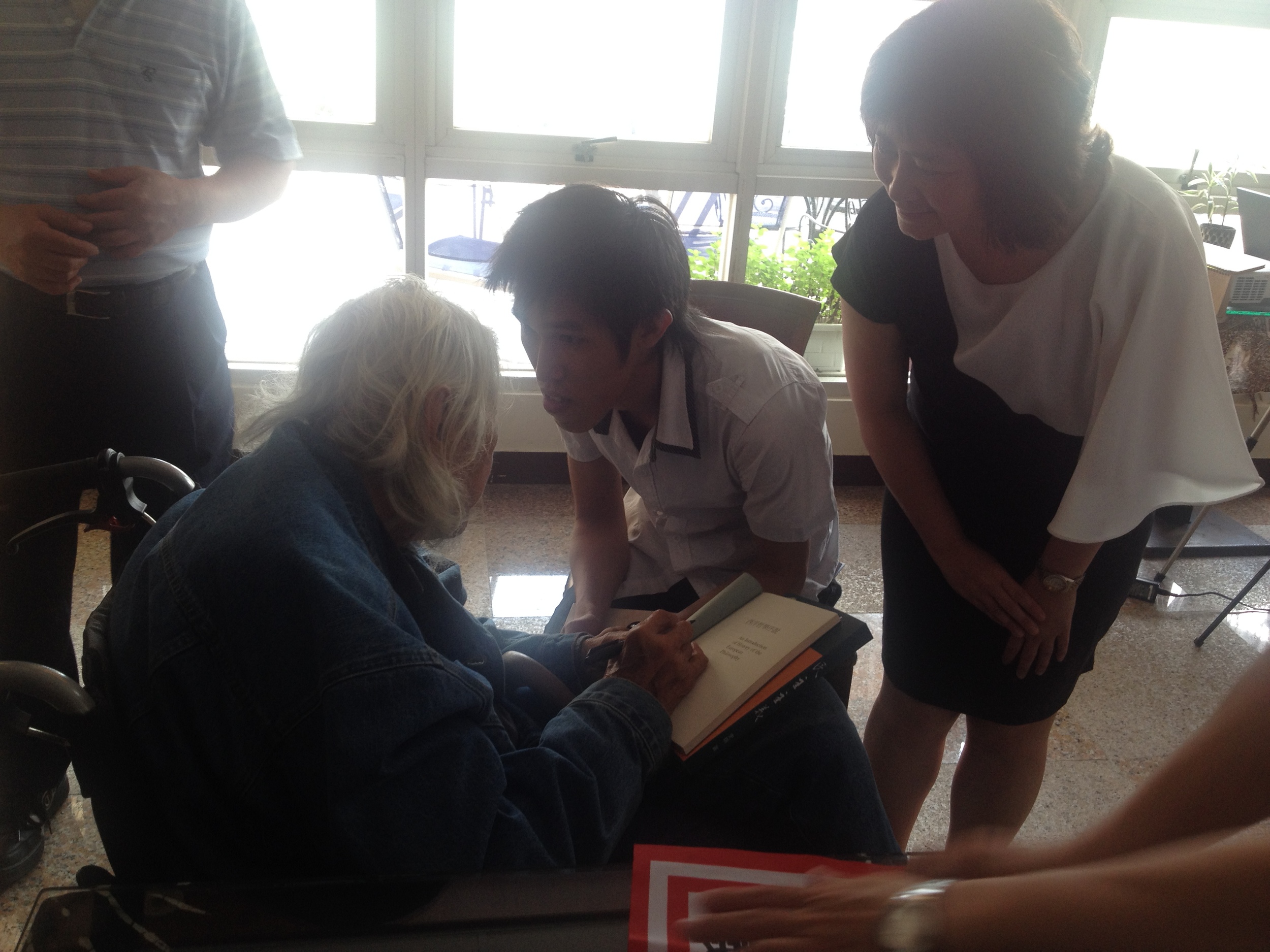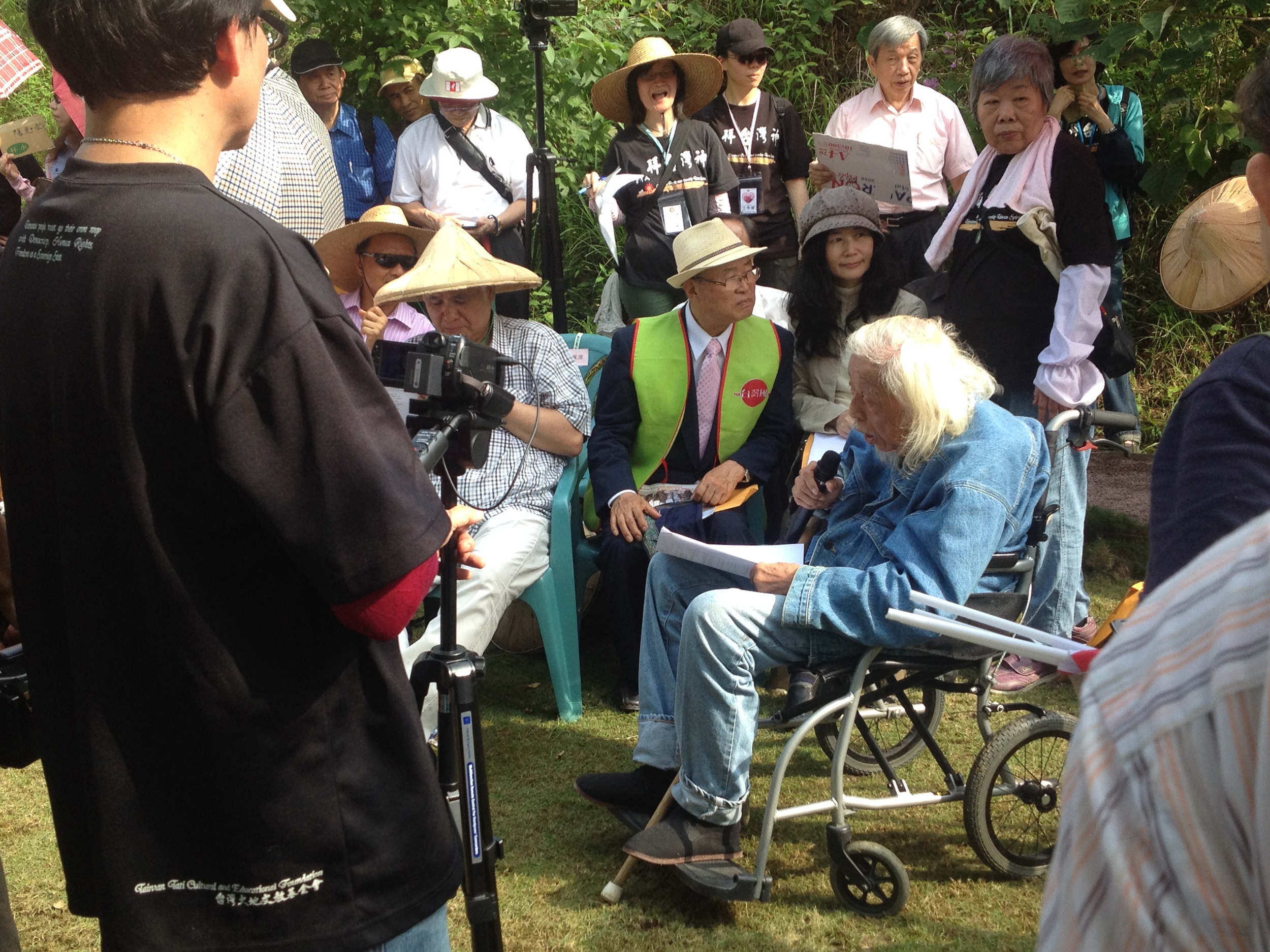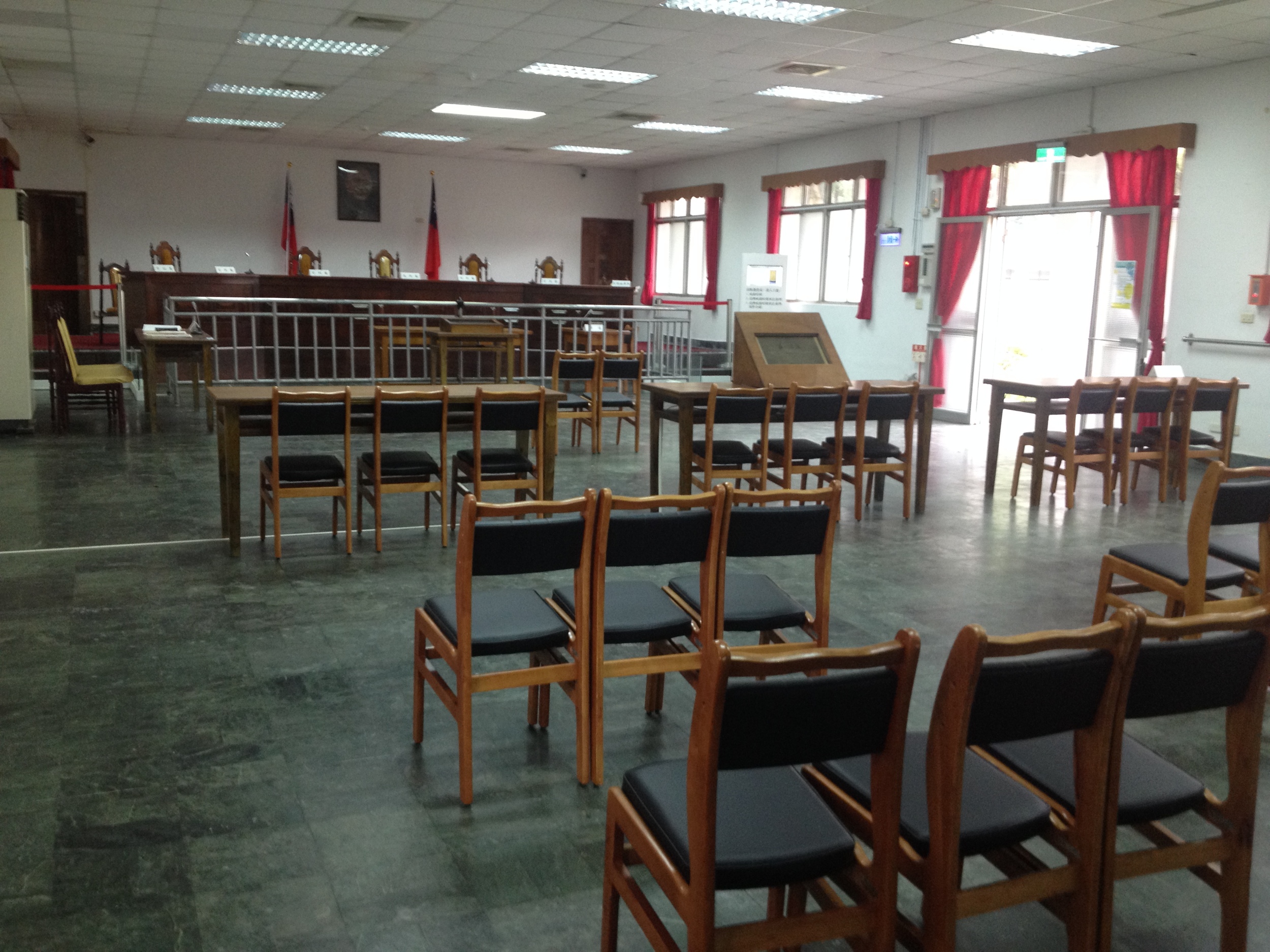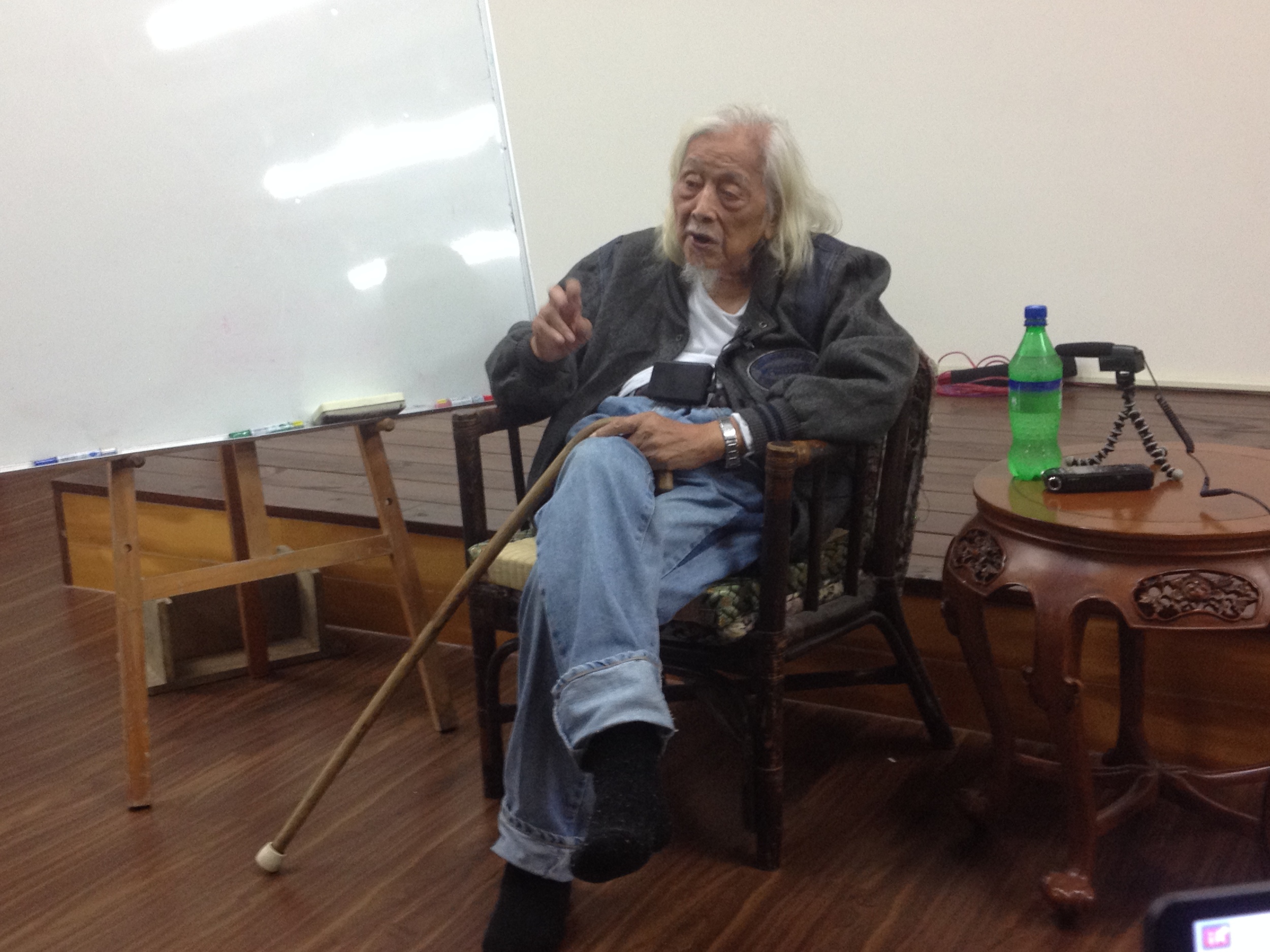Days of May with Su Beng- Part II
May 23- May 24
During my time here in Taiwan I've been accompanying Su Beng to most of his speaking engagements around the island. On the evening of Friday, May 23rd, Su Beng spoke at the National Taiwan University, Convention Center in Taipei.
Photo courtesy of: 林幸蓉
Immediately afterward we left for the Taipei train station to catch a late night train to Hualien. It was a three hour or so train ride. Su Beng had been invited to teach a one-day class (from 9am-5pm) at the National Dong Hwa University on Saturday.
By the time we arrrived in Hualien it was past 11pm. So we went straight to the hotel for the night.
On Saturday morning, we woke up to Hualien's fresh air, and sunny, clear skies. What a lovely change of scenery with mountains in clear view all around us.
Good morning Hualien! But first things first... time for breakfast with Su Beng.
The natural beauty of Hualien can be seen in the distance as Su Beng heads over to start his class.
Su Beng waiting for his class at the National Dong Hwa University to start.
Professor Chen (陳進金), a professor of Taiwan history at the National Dong Hwa University began by introducing Su Beng, and telling the class that ninety-seven-year-old Su Beng had arrived straight from Taipei late last night, around 11pm.
NOTE: Su Beng is considered to be ninety-seven in Taiwan but is ninety-five according to the Gregorian calendar. Read this prior post for an explanation of how someone's age is counted in Taiwan.
Professor Chen was the facilitator for Su Beng's class that day and Su Beng's most attentive student! I watched Professor Chen as he sat front row and center, dilligently taking taking notes and listening intently to Su Beng.
On the screen behind Su Beng, simultaneous translation in written Chinese characters was being provided. As Su Beng spoke, Bin Hong (one of Su Beng's assistants) typed what he was saying in Chinese characters. Yes, that's right, she was typing a Chinese translation of what Su Beng was saying in Taiwanese. You may be wondering why the students needed translation.
When Su Beng speaks publicly, he prefers to speak in Taiwanese. That's what he's most comfortable speaking in. Actually, since Su Beng was born during the Japanese era of Taiwan, his "first" language is a toss up between Japanese and Taiwanese.
But why don't a lot of students or young folks understand Taiwanese? Because they've been educated in Mandarin Chinese. When the Nationalist Chinese party (Kuomintang) fled from China to Taiwan, they declared that Mandarin Chinese would be the official language going forward and also banned the usage of other languages like Taiwanese, Hakka or Aborgine. They exercised this policy vigilently and students were punished for speaking languages other than Mandarin Chinese in school. Over several generations, without formal language classes in Taiwanese, Hakka or Aborgine, people's language proficiency has consequently eroded.
During the break many students who had brought their own copies of Su Beng's book TAIWAN'S 400 YEAR HISTORY lined up to have him autograph their books.
When Su Beng's book was initially printed and published, it was immediately banned by the Chinese Nationalist authorities in Taiwan. But people found a way to get a hold of it. Copies circulated underground and people copied and reprinted it- with Su Beng's permission. Afterall, Su Beng was motivated to write this book because he thought that the people of Taiwan needed to know and understand their history in order to know who why are, where they had come from and what they'd want for their nation going forward.
Technically the title of the Chinese language version should be translated as THE TAIWANESE PEOPLE'S 400 YEARS OF HISTORY (台彎人四百年史).
Below is a photo of a rarely seen copy of Su Beng's book, 台彎人四百年史 with an orange/yellow cover.
Wherever we go with Su Beng, people often stop him for a photograph or autograph. I have seen many different versions of THE TAIWANESE PEOPLE'S 400 YEARS OF HISTORY floating around. Probably the earliest version was the one with a green hardcover, I've also seen a red soft cover version, a navy blue hardcover version, a coffee colored cover and a three volume set consisting of two black and one white hardcover. One could probably guess the origin of the book by looking at its cover. In other words, by looking at the cover you could probably guess from whom or where the book came from. So I guess you really could "judge a book by its cover" in this case.
During a few of the breaks Bin Hong and I took the opportunity to take some photos outside of the university's campus and surroundings.
The deck right outside of the classroom. Photo courtesy of : Bin Hong
Conversing with Su Beng during lunchtime.
Photo courtesy of Bin Hong.
I've been to several of Su Beng's classes and talks at this point and I have to say that Professor Chen did an excellent job of setting the pace for the class. He made sure that there were breaks throughout the day and before each break he'd summarize and highlight the most important points of what Su Beng had said.
At the end of the class, people of course lined up asking Su Beng to autograph things- like this flag that Su Beng gave out. The Chinese characters on the flag: 台彎民族主義, translate as "Taiwan Nationalism."
Below is a photo taken at dinner at the end of the day before we headed back to the train station to catch a train back to Taipei.
When we arrived back in Taipei it was nearly midnight!
Photo courtesy of: Jolan Hsieh
May 31- June 1
The following weekend (May 31-June 1) Su Beng was back at the Taipei train station and on the way to Taichung.
He had been invited to a ceremony for the unveiling of a monument commemorating the Taiyuan incident at the Taiwan Tati Cultural and Educational Foundation. In brief, the Taiyuan incident involved group of politicial prisoners at the Taiyuan prison who planned to takeover the prison and began a guerilla campaign aimed at realizing independence for Taiwan.
Afterward Su Beng was going to give a one and a half day class also at at the Taiwan Tati Cultural and Educational Foundation.
A rare photo of me with Su Beng at the Taipei train station, taken by his assistant Bin Hong. I was posting photos that I'd just taken of Su Beng to Facebook.
Photo courtesy of Bin Hong.
Su Beng on board Taiwan High Speed Rail with his live-in assistant Mr. Lee.
The bread that Su Beng was eating in the photo above, and shown in the photo below is called “kiam gong bian” (in Taiwanese). When Su Beng was in Maryland in 2011, I paid him a visit and brought him some New York bagels. At the time he had said that they reminded him of something called “kiam gong bian.” So I had a chance to try "kiam gong bian." They were homemade and so delicious! The texture is definitely similar to a bagel, but I found it much softer and less dense than a bagel.
We had to walk up a hill to get to the site where the monument was. Meanwhile Su Beng was pushed up the hill slowly in his wheelchair. When we were two-thirds of the way there, Su Beng insisted on walking. Su Beng is not that ambulatory these days and now walks hunched over with a stoop. So it is really quite an effort for him to walk in general, nevermind walking up a steep hill!
I didn't take any photos of this since I was busy capturing this on video. I often find myself torn between shooting video or taking photos of Su Beng. in most cases I choose to shoot video because I reason that if I need a photo, I could always just get a frame from the video footage after the fact.
Here's a photo of Su Beng at the top of the hill waiting for the ceremony to begin. There were many former political prisoners, relatives of political prisoners, and Taiwan history experts at the event.
Su Beng speaking at the event.
Some would say that the Jingmei Military Detention Centre (景美軍事看守所), now a Taiwan Human Rights Memorial and museum in Taipei, would have been an ideal spot for a monument commemorating the Taiyuan incident but I won't get into why the monument isn't there. Earlier that week I had happened to stop by Jingmei. It had been on my list of places to visit in Taipei.
Here are some photos from my visit:
This what the courtroom for the Formosa Incident (aka Kaohsiung Incident) looked like.
This is a photo of the visiting area, where people could visit with and speak to the political prisoners being held there. Prisoners and their guests were not allowed to speak in any languages other Mandarin Chinese.
See the slots at the bottom of the floor outside of the doors? Meals were passed through these slots into the cells for prisoners.
White liles were placed by the monument commemorating the Taiyuan incident at the Taiwan Tati Cultural and Educational Foundation.
Later that Saturday evening, Su Beng gave part I of class at the Taiwan Tati Cultural and Educational Foundation. Part II was on Sunday.









































